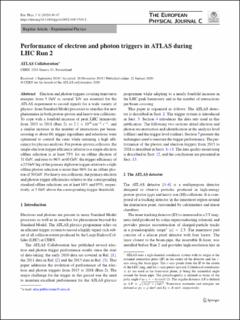Performance of electron and photon triggers in ATLAS during LHC Run 2
Aad, Georges; Abbott, Brad; Abbott, Dale C.; Abed Abud, Adam; Abeling, Kira; Abhayasinghe, Deshan Kavishka; Abidi, Syed Haider; AbouZeid, Hass; Abraham, Nadine L.; Abramowicz, Halina; Bjørke, Kristian; Bugge, Magnar Kopangen; Cameron, David Gordon; Catmore, James Richard; Garonne, Vincent; Gramstad, Eirik; Hellesund, Simen; Morisbak, Vanja; Oppen, Henrik; Ould-Saada, Farid; Pedersen, Maiken; Read, Alexander Lincoln; Rye, Eli Bæverfjord; Røhne, Ole Myren; Sandaker, Heidi; Vadla, Knut Oddvar Høie; Buanes, Trygve; Djuvsland, Julia Isabell; Eigen, Gerald; Fomin, Nikolai; Lee, Graham Richard; Lipniacka, Anna; Martin dit Latour, Bertrand; Stugu, Bjarne; Træet, Are Sivertsen; Abreu, Henso; Abulaiti, Yiming; Acharya, Bobby S.; Achkar, Baida; Adachi, Shunsuke; Adam, Lennart; Adam-Bourdarios, Claire; Adamczyk, Leszek; Adamek, Lukas; Adelman, Jareed; Adersberger, Michael; Adigüzel, Aytül; Adorni, Sofia; Adye, Tim; Affolder, Anthony Allen; ATLAS, Collaboration
Journal article, Peer reviewed
Published version

View/
Date
2020-01-22Metadata
Show full item recordCollections
- Department of Physics and Technology [2161]
- Registrations from Cristin [10399]
Abstract
Electron and photon triggers covering transverse energies from 5 GeV to several TeV are essential for the ATLAS experiment to record signals for a wide variety of physics: from Standard Model processes to searches for new phenomena in both proton–proton and heavy-ion collisions. To cope with a fourfold increase of peak LHC luminosity from 2015 to 2018 (Run 2), to 2.1×1034cm−2 s−1, and a similar increase in the number of interactions per beam-crossing to about 60, trigger algorithms and selections were optimised to control the rates while retaining a high efficiency for physics analyses. For proton–proton collisions, the single-electron trigger efficiency relative to a single-electron offline selection is at least 75% for an offline electron of 31 GeV , and rises to 96% at 60 GeV ; the trigger efficiency of a 25 GeV leg of the primary diphoton trigger relative to a tight offline photon selection is more than 96% for an offline photon of 30 GeV . For heavy-ion collisions, the primary electron and photon trigger efficiencies relative to the corresponding standard offline selections are at least 84% and 95%, respectively, at 5 GeV above the corresponding trigger threshold.
